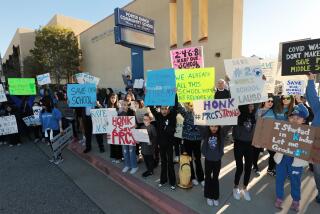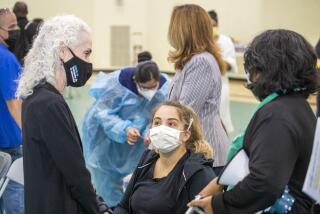Editorial: Are LAUSD students really ready for college?
In a burst of optimism, the Los Angeles Unified school board voted in 2005 to require all students in the district to pass a full set of college-prep courses in order to graduate high school. Recognizing that it would be difficult and time consuming to prepare for such a change, the board announced that the rule wouldn’t take effect for 12 years. That time is now up; beginning this school year, every student who hopes to graduate must for the first time earn a grade of D or better in a set of courses that includes four years of English and three years of math.
Join the conversation on Facebook >>
But it was a poorly conceived mandate from the start. It wasn’t a surprise to most observers that this ruling from on high didn’t magically improve instruction, curriculum or learning. Nor was it terribly surprising when the district announced in December that because of the new rules, it expected to face a huge dip in its graduation rate this year — from the 74% it had reached after years of trying, down to a gloomy 54%. And it would have been a lot worse than that if the board hadn’t previously dropped an even more onerous requirement that students get a C or better in all those courses, which would qualify them for admission to the California State University system.
That was where things stood until last week, when the seemingly magical happened. Although there have been only a few weeks of school since the December report, L.A. Unified announced that suddenly the expected graduation rate is up to 63% and might go as high as 80%.
How did this come about? Thanks largely to the online “credit-recovery” courses that students were allowed to take in order to pass courses they previously had failed. And though the district probably had no choice but to allow this lest its own bad policymaking unfairly rob students of a diploma, some legitimate questions are now being raised about whether all these students have truly mastered the material that had previously eluded them.
Probably no one frets about dropouts more than Russell Rumberger, director of the California Dropout Research Project at UC Santa Barbara, and he takes a skeptical view of online credit-recovery programs. Not that there aren’t good ones, he says, and he acknowledges that there are online courses that suit the learning styles of some students. But there are also quick-fix models that do not impose the kind of rigor and standards that students would find in a classroom. He’s seen online English courses that conferred an A grade after requiring a single book and about 12 hours of computer work, as opposed to the five books and more than 100 hours of instructional time that a regular English class would have required.
L.A. Unified says that’s not what’s happening and that it has done quality control to ensure that its credit-recovery classes are meaningful. Students spend about 60 hours on the courses, officials say, and must pass unit tests to get credit. Students are overseen in their work by teachers.
Still, there’s some apparent concern even on the board about the speed with which the district turned the numbers around. “I love the progress that has been made,” said board member Monica Ratliff at a meeting this week. But “are these credit-recovery courses really rigorous courses? How do we know? What is our evidence?”
Setting high standards for graduation is a fine idea, but they must be achievable or else they can be counterproductive. And once they’re set, students must be helped to meet them fair and square. Not through shortcuts or last minute brush-ups. That means building a solid scaffold of curriculum, instruction and other programs that improve actual learning, which was supposed to be the goal all along.
Follow the Opinion section on Twitter @latimesopinion and Facebook
More to Read
A cure for the common opinion
Get thought-provoking perspectives with our weekly newsletter.
You may occasionally receive promotional content from the Los Angeles Times.






